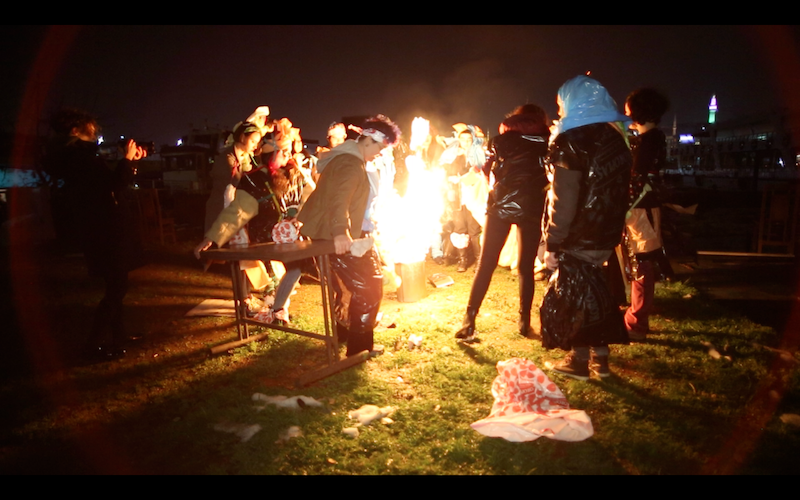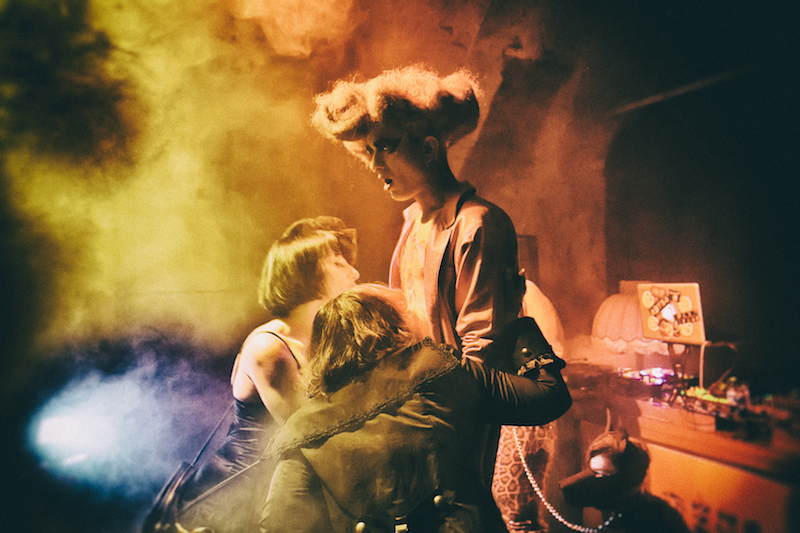 "PostFluxDogGames", 2014, photo by Ayşe Kaya © Istanbul Queer Art Collective
"PostFluxDogGames", 2014, photo by Ayşe Kaya © Istanbul Queer Art Collective
Founded by the three artists Tuna Erdem, Seda Ergul and Onur Gökhan Gökçek in 2012, the Istanbul Queer Art Collective is a performance collective based in Istanbul. Recently, Leman Sevda Darıcıoğlu and video artist Burak Serin have joined the collective and opened it to further collaborations. Having performed more than 20 performances around the world, their recent project “Fluxus Remakes” re-stages and "queeryfies" fluxus happenings, inviting participants and viewers to try, experience and – most importantly – to fail with them. This is because neither perfection or virtuosity, but incompetence and failure is what the collective explores. Engaged in political and social discussions, it's possible to come across their happenings in a nightclub, a park, an ancient site or simply anywhere around Istanbul. Moreover, the founders Tuna Erdem and Seda Ergul are not only engaged in Istanbul's offline art world, but they also run the art blog sanatsepeti, in which they write about their experiences through exhibitions and performances. In our interview, I talked to the co-founders Tuna Erdem and Seda Ergul about how clichés of orientalism and of being queer merge and meet in their practice, about how the Turkish occupy movement influenced their performances and what it exactly means to practice a "queer art of failure".
Mine Kaplangi: How did you begin forming your independent performance collective?
Queer Art Collective: When we founded the collective in 2012, a tide of urban development projects that have gradually expanded since then, was threatening the public space and the diversity of lives within the centre of Istanbul. It was the part of the city, which is a must see for all tourists with its history of cultural conflict, subcultural practices, minority ghettos and brutal gentrification. But moreover, it was our home, in which we lived, frequented art galleries, partied, saw movies, sat in parks, carried banners in demonstrations and most importantly, once a year on the last Sunday of June, joined the gay pride parade in full costume. We had an urge to claim this space as our own, to express what it meant to us, to document the juxtaposition of so many contradictions that we found as striking and beautiful. We wanted to perform in it, with all the possible meanings and associations that this loaded word conveys.
On the other hand the collective also came out of our experience of gay culture in Istanbul. We are a group of friends who spend days preparing for the Pride march, fully enjoy impromptu dressing up sessions, turning whatever at hand into a costume and being stared at by people in our daily lives. Since being ourselves was regarded as a performance in this dominant culture we decided to bring these experiences together with the theoretical work we were doing on queer and our academic work on art and to express ourselves through the avant-garde performances with a queer twist to them.
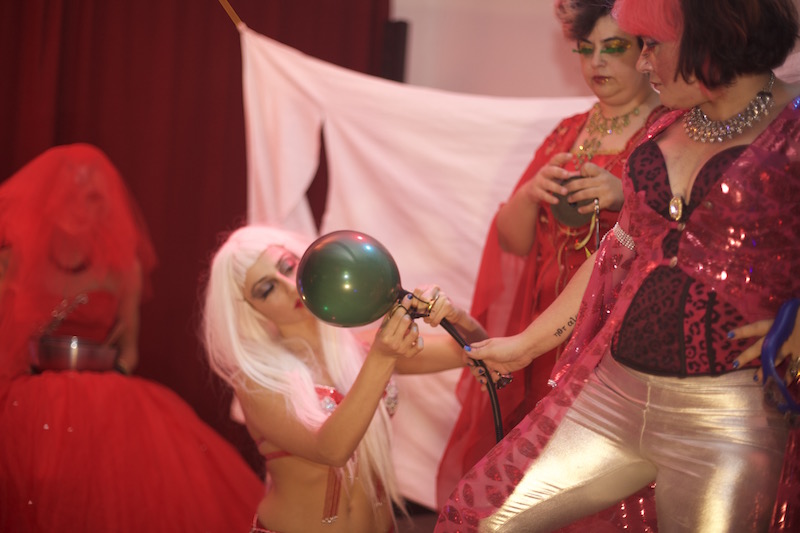 "Henna Night", 2015, photo by Fırat Uzun, © Istanbul Queer Art Collective
"Henna Night", 2015, photo by Fırat Uzun, © Istanbul Queer Art Collective
MK: Your performances are strongly influenced by aspects of Fluxus and Dada. In the “Fluxus Remakes” historic performances are being iterated and turned into a "queer" language. Why do you encourage this kind of historic "repetition"?
QAC: “Fluxus Remakes” is an on-going, long term project of the collective. The first examples of Fluxus event scores date back to John Cage’s “Experimental Composition” class at the New School. These event scores were considered as compositions – so they are meant to be interpreted again and again and we wanted to re-enact as many of them as we can.
By remaking them we place ourselves in the midst of open-ended debate, which considers contemporary art practices in Turkey in general as a second-hand copy of Western art and artists as cheap copyists at best. In fact, being a lesbian is often referred to as something we have “copied” from the West. We own our position, since what we seek in our art is not originality. Performing the event scores that were written in a time and environment different than the one we are living in now enables us to stir the events, meanings, and responses peculiar to this place at this time and it is what renders each and every performance unique. We believe that every performance is endlessly re-enactable and every time it is performed it’s meaning renews and prospers. What we make refills a western frame of mind with local resonances and fails to grasp the issue with east west dichotomy.
For instance, for "Les Belles de Nuit", a gender-bender art festival held in Zurich, we did a performance named “Henna Night”. Henna night is the traditional Turkish version of a bachelorette party where both the bride to be and her female friends get henna burned on to their hands in celebration of the bride. At first sight, what we did on stage looked like a re-enactment of a traditional Turkish ritual of marriage, however it consisted of five different Fluxus performances. Our bride was revealed to be a drag queen. We went further and burned henna on the ass of that "drag bride". There is a vulgar but widely used phrase in Turkish that translates roughly as “to burn henna on your ass” and has the same meaning as the German word “Schadenfreude”. Normally you use henna to celebrate the good fortunes of someone you like. But to use it on your ass means the exact opposite: rejoicing for something bad that happens to someone. The West has a tendency to expect from queers of the East stories of woe and difficulty. In adopting this traditional ritual in a western country, we wanted to playfully represent the “Schadenfreude” inherent in this expectation, as well as its orientalism. As queers from the orient, the traditional rituals of our country, as well as the gender roles deemed universal, are to us merely masks that can only be worn in exaggeration: We bend the genders as we bend the oriental occidental divide by combing the Fluxus performances of the avant-garde West with the kitsch traditional rituals of heterosexuality our own country.
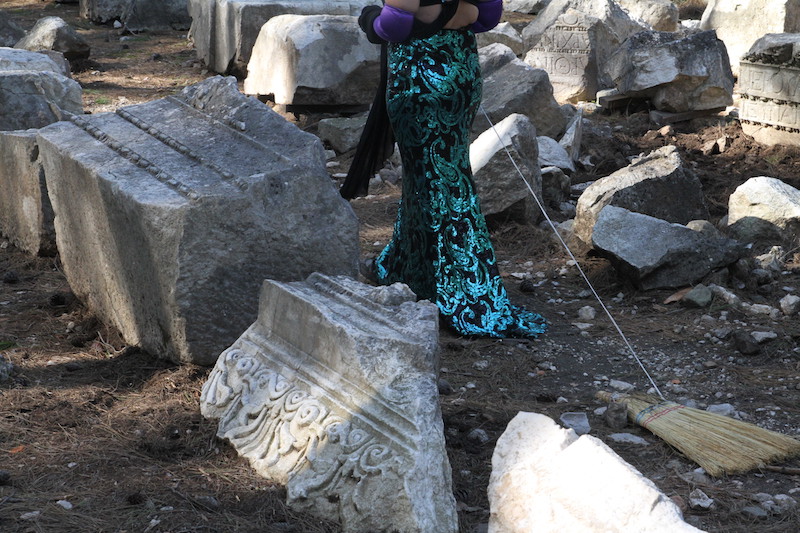
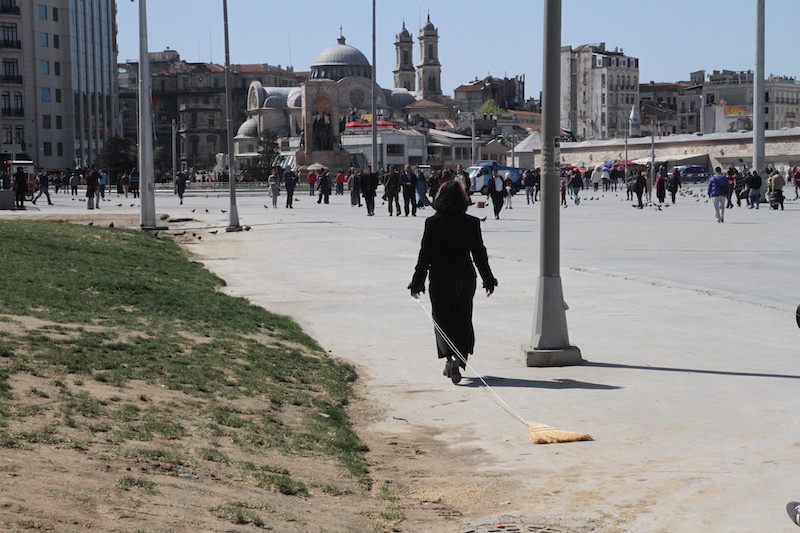 "Sweeping Walk-Phaselis" and "Sweeping Walk-Gezi Park", both 2014, photos by Leman Sevda Darıcıoğlu © Istanbul Queer Art Collective
"Sweeping Walk-Phaselis" and "Sweeping Walk-Gezi Park", both 2014, photos by Leman Sevda Darıcıoğlu © Istanbul Queer Art Collective

 "Sweeping Walk-Phaselis" and "Sweeping Walk-Gezi Park", both 2014, photos by Leman Sevda Darıcıoğlu © Istanbul Queer Art Collective
"Sweeping Walk-Phaselis" and "Sweeping Walk-Gezi Park", both 2014, photos by Leman Sevda Darıcıoğlu © Istanbul Queer Art Collective
MK: Some of your performances are specifically created for certain places and dates, such as Gezi Park and Phaselis. What are decisive factors that make you choose these places for your performances?
QAC: Something stirs us, upsets us or frightens us or moves us and causes joy and we react with art. This is when we decide to do something and this is what determines the where and the when. We joined the occupy Gezi movement, it was the single most important experience of our lives, then it was over and came the local elections. The atmosphere was tense as the election day drew close, some hoped the ruling party will now be defeated after the Gezi miracle, some couldn’t dare to hope, some hoped the electorate would be a slap in the face to those who joined the Gezi movement. We were also tense, so we decided to do a performance on that very day at Gezi Park. Likewise the government green lighted a hotel project at the ancient site of Phaselis, a place we love dearly and visit yearly. We signed the petitions etc. but we had to do something more. Therefore we went to Phaselis and did a performance there. That’s how we decide: we react.
In 2013, the biggest Pride Parade to date happened. It was claimed that 50.000 people had attended. Being a part of that crowd was an incredible experience and we wanted to express what it meant for us. As artists who wanted to physically experience this statistical number, we donned the type of costumes we usually wear for Pride and sat in front of the legendary flag that has been a part of the Istanbul Pride since its inception and we attempted to hammer 50.000 nails, turning Tomas Schmit’s Fluxus event score Sanitas No:151 into an endurance performance. We failed to reach that number although the performance went on for 12 hours. This way 50.000 became the representation of the hard work, which occasionally becomes meaningless but has to be continued nonetheless, of being an open gay or lesbian in Turkey. And since then whenever the 12-hour video and the wooden panels covered in nails are exhibited, some people come and tell us that they would like to be a performer if we ever felt like doing it again.
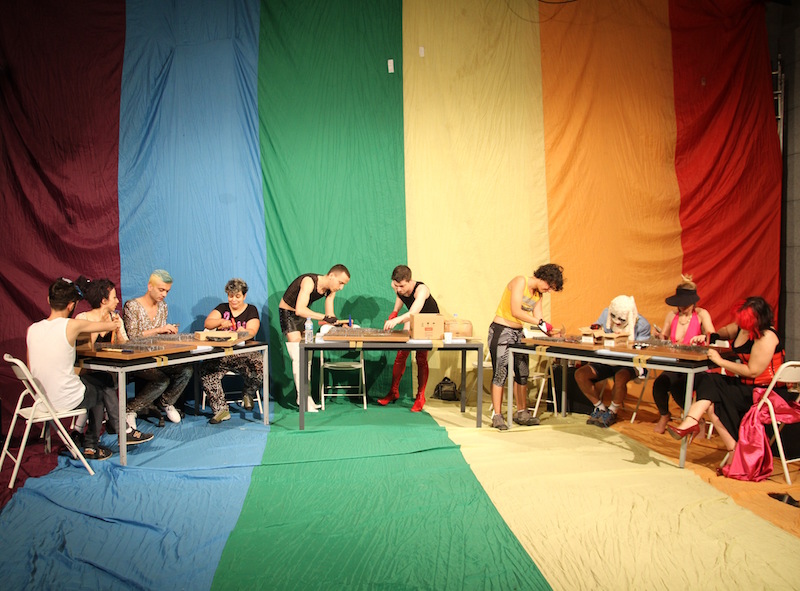 "50000", 2014, screenshot from the video by Burak Serin, © Istanbul Queer Art Collective
"50000", 2014, screenshot from the video by Burak Serin, © Istanbul Queer Art Collective
 "50000", 2014, screenshot from the video by Burak Serin, © Istanbul Queer Art Collective
"50000", 2014, screenshot from the video by Burak Serin, © Istanbul Queer Art Collective
MK: Your performances remind of the "do-it-yourself" understanding of the Fluxus Era, in that sense eliminating the elitist and sharp borders of contemporary art. Is there a specific methodology that you want to sabotage or pass on?
QAC: What we do as performers does not require technical competence; on the contrary: we continuously display our shortcomings and failures. The more we strip ourselves from the virtuosity, the more the ancient, deep and strong structure that separates the performer and the audience becomes visible. In this sense, our performances are an invitation for the audience to think about that structure and to ask themselves “why am I here, why am I not there, what makes me stay here and keeps me moving towards the stage?” The answer could no longer be “I am not trained” or “I don’t have talent”. Then, what could it be? Sometimes "invitation" can be heard as "invasion". We don’t ask the audience to invade the stage. We don’t ask them to accede to our invitation immediately. We want them to take their time and to perform at any time and place they choose.
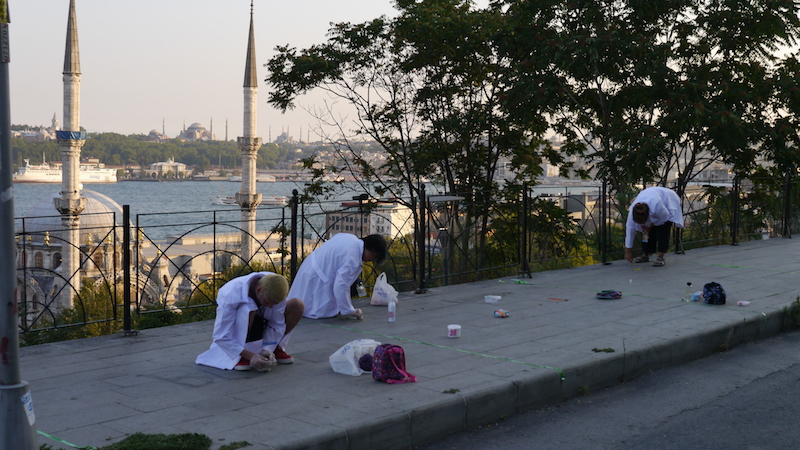 "Street Cleaning Event", 2012, photo by Burak Karacan © Istanbul Queer Art Collective
"Street Cleaning Event", 2012, photo by Burak Karacan © Istanbul Queer Art Collective
MK: Often you enable your audience to not only experience but also to participate in performances, blurring the threshold between performance and non-performance. Could you tell me about examples in which the audience became a substantial part of the performance?
QAC: Audience participation takes on different meanings with each performance. When we perform in public spaces we do not announce the performance and our audience is merely the passers-by and their reactions are their participation. For instance during the "Street Cleaning Event" in which we cleaned a part of a sidewalk with things like sanitary pads and tooth brushes some old women came to us and tried to explain that we were using the wrong material for this kind of job. After a while a group kids came and speculated that we were cleaning some graffiti on behalf of the government. In short, everyone interpreted what we were doing according to their own worldview and the kids turned out to be clairvoyant since exactly one year later the sidewalk we cleaned was covered in graffiti due the occupy Gezi movement and the government indeed did cover it up.
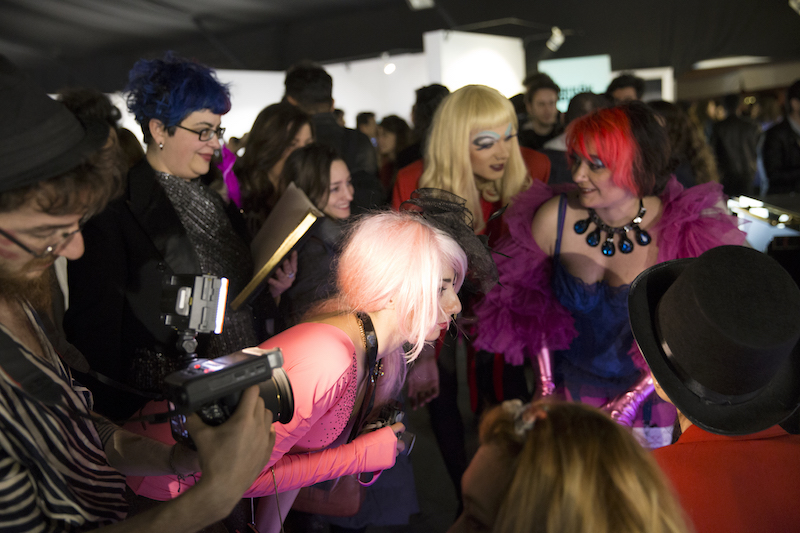 "The Empirical Portrait of the Art Lover", 2015, photo by Osman Nuri İyem © Istanbul Queer Art Collective
"The Empirical Portrait of the Art Lover", 2015, photo by Osman Nuri İyem © Istanbul Queer Art Collective
With other performances we seek out participation, like "The Empirical Portrait of the Art Lover", which was the opening performance of last year’s Mamut Art Project, where we went to the invited guests and asked them silly questions and measured their arm length, perimeter of their wrist, width of their shoulders etc. with ribbons. We photographed their shoes. Our plan is to create statistical charts with the data we collected during this performance and exhibit the ribbons together with our video. So the participants in this case will turn into the subjects of our “experiment”. And then there are performances like the "Henna Night" where we ask the audience if anyone would like to have henna burned on their hands and there was a queue formed by the participants. Sometimes eager audience queue up to come to the stage even if we did not ask them to, like in the case of the “PostFluxDogGames” performance where we were putting on lipstick and kissing a drag queen and the audience wanted to join in.
Sometimes we expect that there will be some form of participation and there is none. Like the performance we did for the !F Istanbul International Independent Film Festival. We wrote a fake synopsis for a non-existent film, which was printed in the catalogue of the 14th instalment of the festival and became part of the official program with a scheduled screening. We edited footage from the documentation of a previous performance of ours using mostly the frames that showed the audience watching us perform. A few minutes after the fake movie started, we as the four members of the Istanbul Queer Art Collective walked on stage clad in glamorous outfits and began painting the screen with black paint. We assumed someone from the audience would at least ask what was going on but they watched on without any visible reaction except a few people who checked their catalogues to ascertain they were at the right screening.
However as we said earlier there are those who take their time in responding to our invitation and ask us after the performance how they could join us in our future endeavours. That is why we did a workshop we called “Out and About with The Istanbul Queer Art Collective”. We made an open call to people who wanted to perform with us and with the 15 people that answered our call we dressed up and went out on the streets to re-enact three different Yoko Ono performances.
MK: Do you intend to repeat all the Fluxus performances from the book?
QAC: Some of these performances are not meant to be done at all – let alone repeated. Some are there to show the limits of what can be done. For instance there is this performance that asks you to commit suicide on stage. Or one that tells you to become pregnant with twins for 18 months. Of course, even these can be interpreted and not taken literally. This is not something you can plan ahead, but you can always be open to it and when you are, performance re-enactment opportunities come from the most unexpected places. However, we are committed to the queer art of failure. We have no ambition to “do it all”. The best would be to have tried and failed.
MK: You schedule involves performances, exhibitions and projects in Turkey and abroad. How do you arrange your annual program? How much is planned, how much is spontaneous?
QAC: We don’t have a yearly program. Programming in the sense of knowing in advance, organising the future, controlling what is and what is to come and most importantly determining in advance is antithetical to what we do and want to do. We want to be indeterminate in the sense John Cage explained the term. We want to be open to chance encounters, which we believe is what life is all about and art should be a part of life. We are “contemporary” in that sense, too, since we do not know what will happen tomorrow that will stir us to express ourselves. We live open to opportunities which can be places, events, people, concepts being curated anything that might motivate us to create but we don’t have a plan, least of all a career plan which we genuinely believe is the source of most evil in any so called career and art is not a career it is a fundamental human necessity, like sex. Everyone needs to do it and no one should program it unless of course programming sex is your fetish.
MK: Many different people take part in your performances, since the collective has been established. How do you choose them?
QAC: Since you do not need any talent or training to perform in our performances, literally anyone can become a part of the project. For "50.000" we asked people who we knew to have attended gay pride in the previous years and asked them to come as they would dress up for the pride parade. But since we want to encourage literally everyone to become performance artists once someone sees one of our performances and asks if they can join in for another we take care in inviting these people the very next opportunity we find.
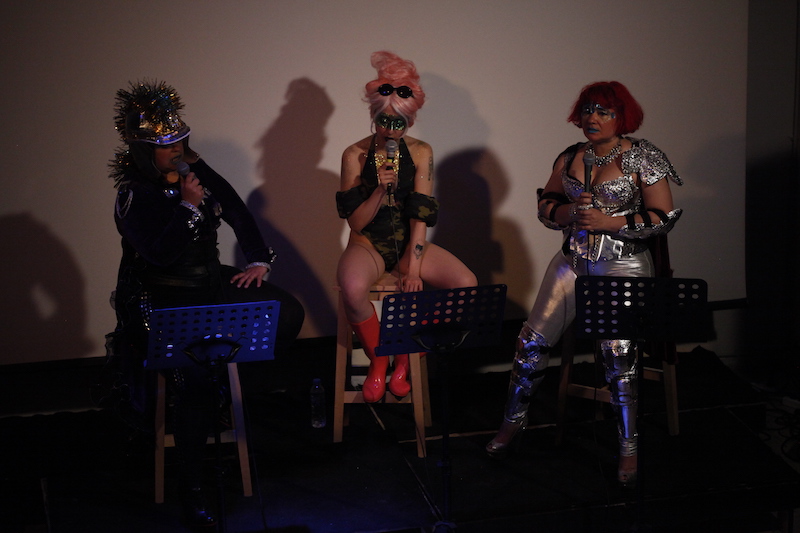 "South: The Border Oath Version", 2016, photo by Burak Serin © Istanbul Queer Art Collective
"South: The Border Oath Version", 2016, photo by Burak Serin © Istanbul Queer Art Collective
 "South: The Border Oath Version", 2016, photo by Burak Serin © Istanbul Queer Art Collective
"South: The Border Oath Version", 2016, photo by Burak Serin © Istanbul Queer Art Collective
MK: Recently, you attended the performance festival "Sound Acts" in Athens with your performance "South: The Border Oath Version". Could you tell me a bit about that project and your experience of the festival?
QAC: "Sound Acts" is a festival that focuses on sound art and there are many fluxus scores that fall in this category. We looked for something that we could queerify and something that would have some resonance to the fact that we would be performing in a neighbour country. In the Fluxus performance score “SOUTH no.3”, Takehisa Kosugi asks the performers to turn the word “South” into sounds by pronouncing every syllable and letter, in every combination possible. In remaking SOUTH, we replace the word “South” with a specific text: the military oath Turkish soldiers are obliged to take each and every time they start their border watch duty. We performed to an audience that did not speak Turkish. However, most of the performance consisted of meaningless sounds where knowledge of Turkish was irrelevant. In fact our aim was to steer away from the inherent stability of language, toward the unstable, performative, immediate, humorous and playful world of sounds. By doing so, we hoped to call into question the inherent stability of physical borders and the conceptual foundations that lie behind our need for them. With that aim in mind we made military costumes for ourselves that were as always also drag queen costumes.
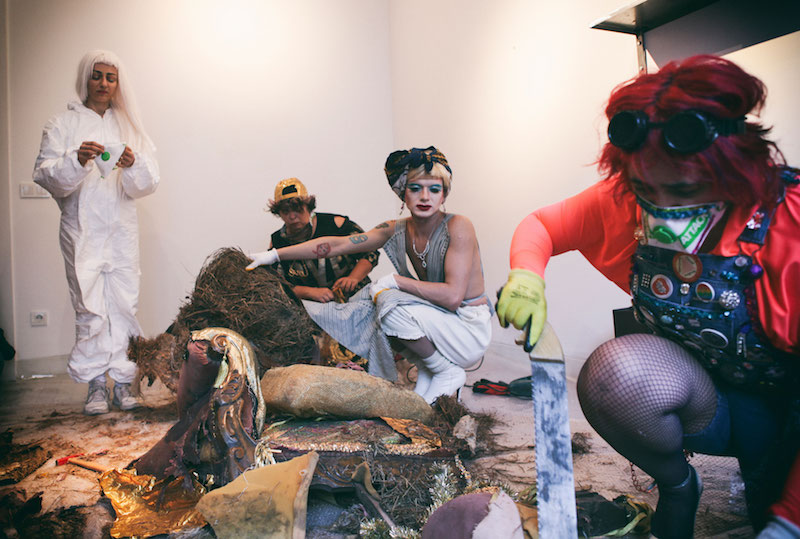 "Koltuk Sevdası", 2016, photo by Eda Sancakdar © Istanbul Queer Art Collective
"Koltuk Sevdası", 2016, photo by Eda Sancakdar © Istanbul Queer Art Collective
 "Koltuk Sevdası", 2016, photo by Eda Sancakdar © Istanbul Queer Art Collective
"Koltuk Sevdası", 2016, photo by Eda Sancakdar © Istanbul Queer Art Collective
MK: You have previously mentioned following the notion of the "Queer Art of Failure". What exactly is this and how is it related to the main motivation of the collective? What type of performances do you consider to be Queer Art?
QAC: In his book "The Queer Art of Failure" Jack Halberstam refers to Quentin Crisp’s words: “if at first you don’t succeed failure maybe your style.” We believe failure is our style; exactly the way “drag style” suits us as cis woman. In fact, we also see our art as “radical drag” the way Renate Lorenz describes it. We do not want to reinforce the culture of competition and ambition. This is what we mean by the queer art of failure. Even when what we do can be considered an endurance performance, we don’t force ourselves to endure until we reach a predefined point. That point is arbitrary. “Continue until you can’t” does not mean for us something like “until you pass out”, it means, “until you don’t feel like going on” and this feeling may be psychological, not physical. We are not trying to turn this in to a sporting event. We are definitely not trying to enforce our iron will on our bodies. We don’t see this as a challenge, and we believe in fragility, failure, precariousness not will power and concurring and pushing beyond.
We search for limits because that is where we are fragile and that is what we value, not because we want to conquer those limits. If we would use this word “conquer” at all, it would be in reference to shame. Exactly the shame caused by fear of failure and humiliation and this fixation of strength and success. And of course the shame of moralising. We don’t want people to look at us and be in awe of our will power, endurance etc. we want them to look at us and say: “that looks so easy even I can do it”, “it looks like fun may be I should do it too” and most of all be encouraged to make an ass out of themselves: that is we want them to think “hey no shame in baring your ass and no shame in becoming an ass every once in a while” we think it is a necessity.
This summer we will be performing at the Zürcher Theater Spektakel, our performance is called “Also No” and based on failure. We will go on stage and tray out a form of street art, like juggling, tightroping, hula-hooping etc. We will do this six times in four days on stage and see if we get any better. Instead of showing the end product of hard work and choreography, we will be showing the incompetence of the process. Instead of the famous Beckett quote “fail again fail better”, we will follow the twitted motto “Am I good? No. But do I try to be better every day: also no."
-> facebook.com/istanbulqueerartcollective
-> sanatsepeti.wordpress.com/
-> facebook.com/istanbulqueerartcollective
-> sanatsepeti.wordpress.com/
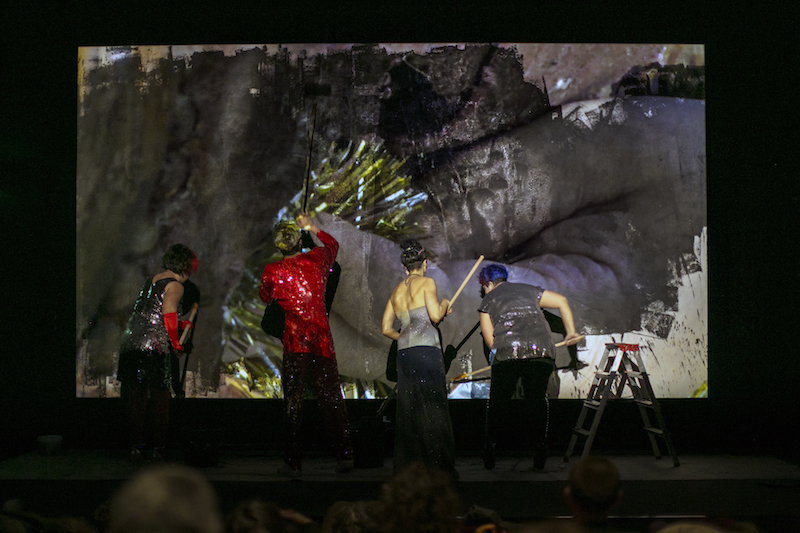 "Watching Queer or the Golden Age of Blue Men", 2015, photo by Ayşe Kaya © Istanbul Queer Art Collective
"Watching Queer or the Golden Age of Blue Men", 2015, photo by Ayşe Kaya © Istanbul Queer Art Collective
